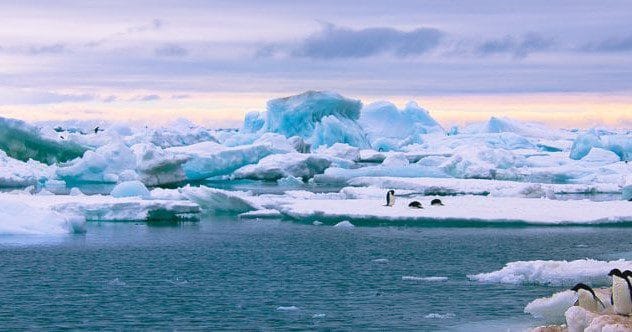Scientists believe the complete melting of Antarctica’s ice is becoming more of a reality than a distant possibility. The sheer size of the Antarctic ice sheet is staggering, covering approximately 14 million square miles—an area equivalent to the combined land area of the U.S. and Mexico. When considering the depth of the ice, the total volume is about 7.2 million cubic miles.
This ice has been accumulating for eons, with layers upon layers freezing over thousands of years. However, industrialization has led to greenhouse gas emissions, and human activity has taken a toll. Some scientists now predict this melting could occur by 2060. To prevent this, significant steps must be taken to reduce global emissions. If carbon emissions aren’t cut, the large-scale melting would be catastrophic.
Some consequences are evident: rising sea levels and severe impacts on global climate and ecosystems. But other potential impacts of this melting event are just as deadly. Let’s explore ten shocking things that could happen if Antarctica’s ice melts in the coming decades.
Gravity Would Radically Shift
While the connection between the melting of Antarctica’s ice and rising sea levels is well-known, the process is more intricate than simply adding melted water to the oceans. According to data scientists, several less obvious consequences would also unfold.
One significant impact of disappearing ice would be a shift in gravity. This alteration could cause some land areas to expand and rise, partially offsetting the sea level rise, but with other major implications. The precise effects on global sea levels and regional land movement are complex and not yet fully understood. However, scientists are concerned about the potential for radical change, which could deliver a sudden and impactful blow to Earth’s delicate ecosystem balance.
Scientists began studying this phenomenon decades ago. In 1875, researcher James Croll posited that the melting of Antarctic ice would lead to an uneven sea rise. This is now known as the “gravity effect.” Croll discovered that sea levels near Antarctica would increase less than the worldwide average, while the northern hemisphere could see a rise up to one-third higher than average. Subsequent calculations by other mathematicians have further refined our understanding of how melting ice impacts regional sea levels.
The core principle remains: Melting ice causes a shift in gravity, affecting sea levels differently across the globe. For instance, ice melt in Greenland could actually lower sea levels nearby while raising them further south. These unequal distributions would make it challenging to safely relocate large populations inland away from rising tides, greatly exacerbating the issue. [1]
Earth’s Axis Would Shift Dangerously
The Earth’s axis doesn’t just rotate smoothly; it also wobbles slightly due to mass distribution across the globe. Between 1899 and 2018, the Earth’s axis shifted by approximately 34 feet (10.4 meters) due to various environmental and man-made factors. Melting ice is already a significant contributor to this problem.
Scientists estimate that more than half of this shift was caused by melting ice, which in turn has altered gravity. Land masses have expanded and contracted, and these changes have affected Earth’s rotation. Although this process isn’t fully understood, it’s clear that melting ice significantly affects the Earth’s axis, with any changes being felt even more profoundly going forward.
The interplay between Earth’s axis and melting ice has been studied for a long time, but the extent of their connection isn’t fully clear. While melting ice contributes to the movement of Earth’s axis, other factors, such as mantle movement, also play roles. Significant consequences can occur even without all of Antarctica’s ice melting.
According to paleoclimatologists, melting ice can create a feedback loop: The movement of the earth’s axis exposes the poles to shifting warm-water currents, accelerating ice melt. Once this process begins, it becomes harder to slow down or reverse, significantly impacting global climate and sea levels. The world is already witnessing some of these effects, and scientists are concerned that the situation will worsen as the melt rate increases. [2]
A Day Is Now How Long?
The melting of all the ice in Antarctica would have complex, interconnected effects on Earth’s systems, making it difficult to predict exactly what would happen. However, researchers know that this event would impact the length of a day. The Earth’s rotation, measured by satellites and astronomical methods, has undergone modest but noticeable changes due to melting glaciers and the influx of meltwater into the oceans.
This “polar wander” process is driven by numerous factors, including climate change. According to Harvard University geophysicist Jerry Mitrovica in 2015, “Because glaciers are at high latitudes, when they melt, they redistribute water from these high latitudes toward lower latitudes. Like a figure skater who moves his or her arms away from their body, this acts to slow the rotation rate of the Earth.”
When ice melts and its water shifts across the globe, it causes Earth to spin noticeably faster or slower, similar to how a figure skater changes their spin speed by moving their arms. The amount of the change depends on the amount of ice that melts.
As this ice-melting process has been ongoing for decades, the length of a day has already increased by thousandths of a second. While the exact change in day length if all of Antarctica’s ice were to melt is unclear, it would be measurable. Some estimates suggest the day could change by as much as 20 seconds in the next few years, and possibly more significantly after that. [3]
Massive Coastal Cities Will Disappear
Antarctica and Greenland contain substantial amounts of ice. Were they to melt entirely, the consequences for life on Earth would be severe. According to National Geographic, if sea levels were to rise as predicted, many coastal cities, including New York, New Orleans, Buenos Aires, Cairo, London, Venice, Shanghai, and Bangladesh, would be completely submerged. Other large land areas would also be severely affected.
This would result in a major disaster for both people and ecosystems reliant on these areas. Millions would be displaced from their ancestral homes and long-standing communities, leading to secondary health, financial, and geopolitical challenges associated with relocation.
If all the ice on Earth were to melt, approximately four-fifths of Australians would find themselves living in areas that would quickly be underwater. This would also impact an area in China currently home to around 600 million people. Denmark and the Netherlands would be almost entirely submerged. Additionally, much of the U.S.’s East Coast, including Florida and the Mississippi Delta, would disappear. Most of Paraguay and large parts of Central America would also be underwater.
Some major cities, like San Francisco and Phnom Penh, would become islands. While Africa might experience less land loss, the rising temperatures would render much of the continent uninhabitable. Scientists estimate that about 40% of the world’s population lives in areas that would be affected by this scenario. A massive sea level rise is clearly a disaster for humanity. [4]
Animal Populations Would Be Wildly Affected
Antarctica may seem cold and lifeless, but it’s actually a diverse habitat for many animal species. Sea birds, penguins, seals, whales, and other marine animals thrive there year-round. However, climate change poses a major threat to many of these species. For example, populations of emperor and Adélie penguins have already declined due to melting ice, and would decline further if conditions worsen.
For now, the chinstrap penguin has taken their place—but scientists worry they may not last long, either. If the ice continues to disappear, there could be devastating consequences for all the species that call Antarctica home. Wildlife biologists continue to sound the alarm, but there’s little to be done as sea levels continue to rise.
The loss of sea ice will also have devastating effects on ice-dependent animals such as seals and whales. Were sea ice to melt, it would mean the end of leopard and Ross seals, as well as minke whales. The disappearance of sea ice would have a ripple effect throughout the entire ecosystem.
Smaller creatures like krill and phytoplankton, which are at the bottom of the food chain, would also be affected. These small organisms are a vital food source for many other species. Their disappearance would likely set off a chain reaction throughout the ecosystem. The ensuing effect would be devastating to wildlife in regions outside the polar regions too. [5]
Water Woes Will Get Worse Across the World
It may be tempting for those living inland to think they’re unaffected by Antarctic ice melt, but glaciologists warn that this isn’t the case. One of the biggest concerns for world populations is the loss of access to clean drinking water.
As sea levels rise, saltwater can infiltrate groundwater reserves further inland, quickly contaminating sources of drinking water. Furthermore, farm irrigation would become much more difficult due to the high salt content. Even those living at elevations above 250 feet (76.2 meters) may find their well water at risk of contamination from rising sea levels.
According to NASA, the world has already experienced negative consequences: Freshwater reserves in Antarctica, Greenland, the Russian Arctic, and the Andes have suffered from melting sea ice. This melting and subsequent sea level rise has disrupted the regular freshwater supply for millions of people who depend on glaciers for their water.
As sea levels continue to rise, more people will struggle to find access to clean, safe drinking water, and this problem will only worsen. Humans living far inland will begin to feel the pinch of water shortages and water treatment issues. Even in places far from Antarctica and its ice shelves, drinking water problems will become a fact of life. [6]
Long-Frozen Microbes Will Be Re-Released into the World
Antarctica’s melting ice isn’t just adding a large amount of water to the planet. It’s also uncovering organisms that have been frozen under the ice for millions of years. In 2011, Chilean researchers studying these microbes found that they can withstand extremely cold temperatures.
The microbes were able to survive in environments with high salt concentrations, extreme acidity and alkalinity, and temperatures as high as 200°F (93.3°C). One microbe was found to withstand radiation 5,000 times more intense than any other organism on Earth, despite being found 50 feet (15 meters) beneath the ice surface, suggesting that these organisms are very strong and potentially deadly.
Researchers have yet to reach a consensus regarding the purpose of these microbes, and they haven’t ruled out any theories. There has been significant debate surrounding these discoveries, and further samples from other bodies of water seem to support the Chilean’s initial findings.
A lake located beneath a mile of ice in West Antarctica produced samples unlike anything else on Earth. They were so unique that they were used as evidence for the possibility of life existing in extreme conditions in space. But scientists don’t know what this means for us! It’s unclear what the consequences could be when these microbes are released. Could it bring mass disease and an end to life as we know it…? [7]
Speaking of Mass Disease…
Antarctic ice has held tiny creatures for around 750,000 years—long before humans existed. If history is any indication, we will almost certainly be vulnerable to the diseases and pathogens these creatures hold. Of course, these microorganisms have long since developed immunity to the pathogens under the frozen ice, but humans won’t be so lucky. Some scientists refer to Antarctica as a “storehouse for genes,” and there are likely many deadly diseases in that storehouse.
The thought of these discoveries sounds like the start of some kind of horror movie! But the consequences could be very real. Biologists have carefully tried unthawing sections of ice and studying the microorganisms within, but even that has proven difficult and deadly. In fact, some fatal incidents have already occurred.
In the recent past, thawed bacteria have spread and caused outbreaks of deadly diseases such as smallpox, bubonic plague, and anthrax. The latter pathogen caused a deadly mini-pandemic that swept across Siberia in 2016. Seeing that destruction play out on a smaller level leads scientists to believe this may not be the only time such an unthawing event occurs. Researchers need to continue studying the potential risks of unfrozen bacteria and viruses to prevent future outbreaks.
As the earth’s ice melts, we continue to put ourselves at greater risk that long-frozen bacteria will be revived. Scientists uncovered evidence of eight-million-year-old bacteria buried deep in Antarctica’s ice sheet. The potential unexpected consequences that could come from this ancient bacteria could usher in an entirely new—and dangerous—world. Once the ice begins to melt in full, stopping the inevitable spread will be difficult. [8]
Antarctica Will Be Greener Than Ever Before
Antarctica is usually depicted as a flat, icy desert, but that hasn’t been the case lately. Glacial scientists recently revealed the existence of various features beneath the ice using advanced mapping technology. These features include over 400 lakes, including the largest in the world, Lake Vostok, along with a deep network of rivers and canyons that surpass the Grand Canyon in size and complexity.
If the ice were to melt, these hidden landscapes would become visible, revealing fascinating ecosystems that could flourish in the most extreme scenarios.
In some parts of Antarctica, this is already happening. New findings show that the previously barren Antarctic is at least partially green. Some areas, like Green Island, are covered in vibrant mosses. While the ice-covered continent is still only about 1% green, the presence of hardy mosses beneath the surface suggests it may be getting greener.
Rob DeConto, a glaciologist from the University of Massachusetts, explained in an interview with the Washington Post that “This is another indicator that Antarctica is moving backward in geologic time, which makes sense, considering atmospheric CO2 levels have already risen to levels that the planet hasn’t seen since the Pliocene, 3 million years ago, when the Antarctic ice sheet was smaller.” [9]
Ocean Currents Will Change Course
Thermohaline circulation is a global system of deep-ocean currents driven by differences in temperature and saltwater salinity. According to the NOAA, surface ocean currents are wind-driven, but the poles and the presence of ice play key roles in creating deep-water currents.
This happens when water freezes into sea ice, increasing the water’s saltiness. The denser, saltier water sinks and is replaced by less-salty water from the surface. This cycle, known as the global conveyor belt, alters how ocean water moves around the world.
Antarctica plays a vital role in regulating both temperature and salinity in the southern oceans, and melting sea ice would radically alter those oceans. If the Antarctic ice sheet were to disappear, it could have negative consequences. Because Antarctica controls the circulation of salt, animal species in the southern hemisphere have adapted to that ecosystem.
Millions of years of evolution would be undone as currents alter course. Fishing stocks would move and disappear, potentially causing mankind to run out of a major global food source. Other changes in saltwater concentration and freshwater spread would change the course of life for countless water-based species. [10]
BONUS: Get Ready for Another Ice Age
If the ice in Antarctica were to melt, one consequence would be the loss of animal life across many parts of the world, as many species depend on the ice for their habitat. There would also be major disruptions to global weather patterns, ocean currents, winds, and rainfall. Melting ice would significantly alter the balance of salt and freshwater in the world’s oceans.
Other, far worse, things could also happen: Ice melt could bring about changes that would eventually lead to another Ice Age. This occurred millions of years ago when icebergs broke off from the Antarctic ice sheet and drifted into neighboring oceans before melting. The influx of freshwater from the melting icebergs disrupted the global balance of salt and freshwater, leading to a domino effect of environmental changes.
The ocean absorbs carbon dioxide, which helps reduce greenhouse gas emissions and global warming. However, this process can also lead to cooling. Researchers studied a sediment core from the ocean floor 500 miles (804.7 kilometers) off the coast of southern Africa, which included a record of the last 1.6 million years.
Their analysis revealed that, during every Ice Age, there were signs of melting Antarctic ice that contributed greatly to the cooling. Today, we face conditions similar to the beginning of that ancient Ice Age when it comes to glacier melt. Ice Age conditions will take eons to occur, so we won’t be around to see it. But the changes being kicked off recently will have incredible consequences for thousands of years. [11]
The melting of Antarctica’s ice would trigger a cascade of dramatic changes across the globe. From shifts in gravity and the Earth’s axis to rising sea levels and the re-emergence of ancient microbes, these consequences highlight the profound interconnectedness of our planet’s systems. Addressing climate change and reducing emissions is more critical than ever to mitigate these potentially catastrophic impacts.
What do you think about these potential changes? Leave your comment below!










